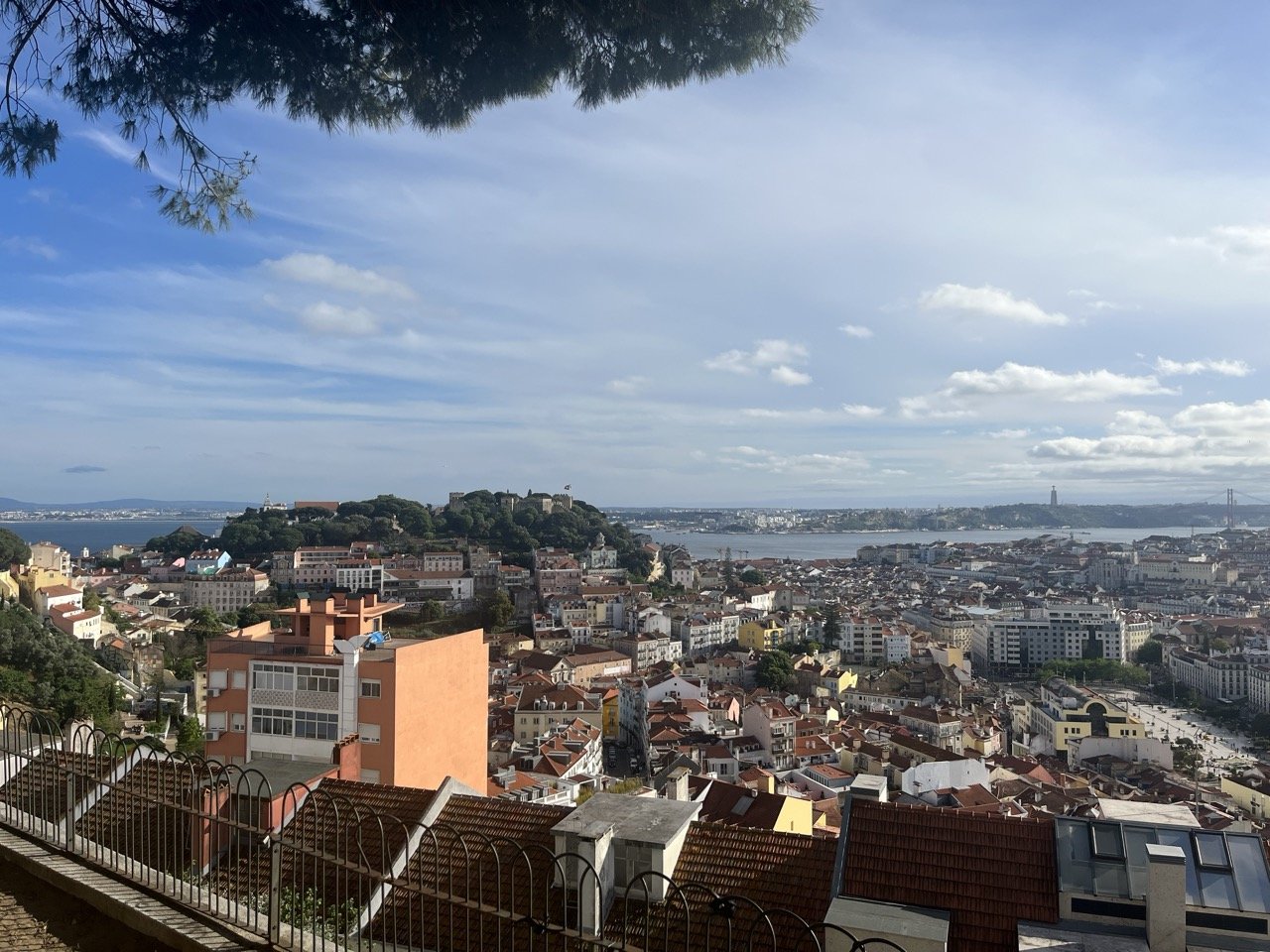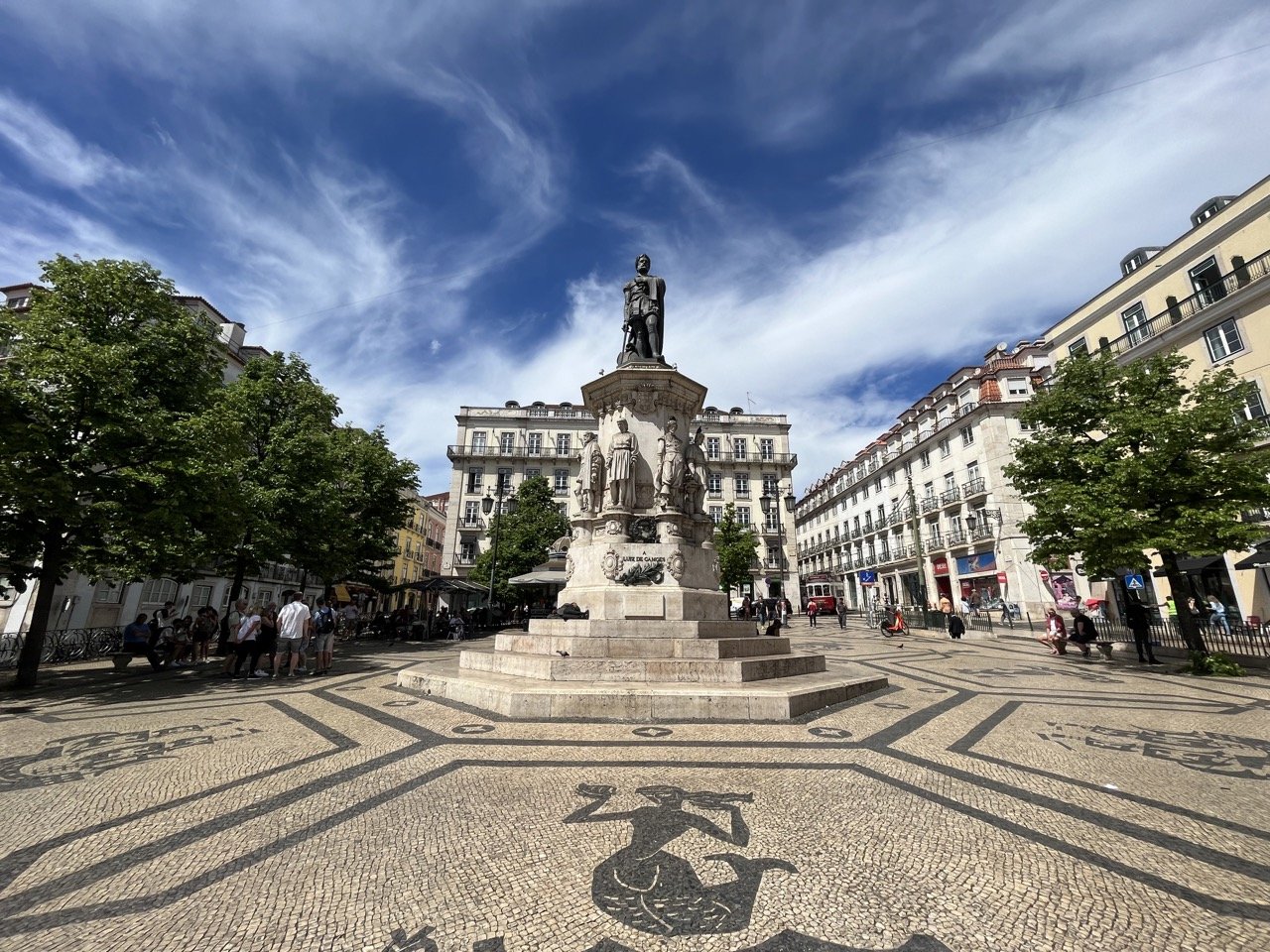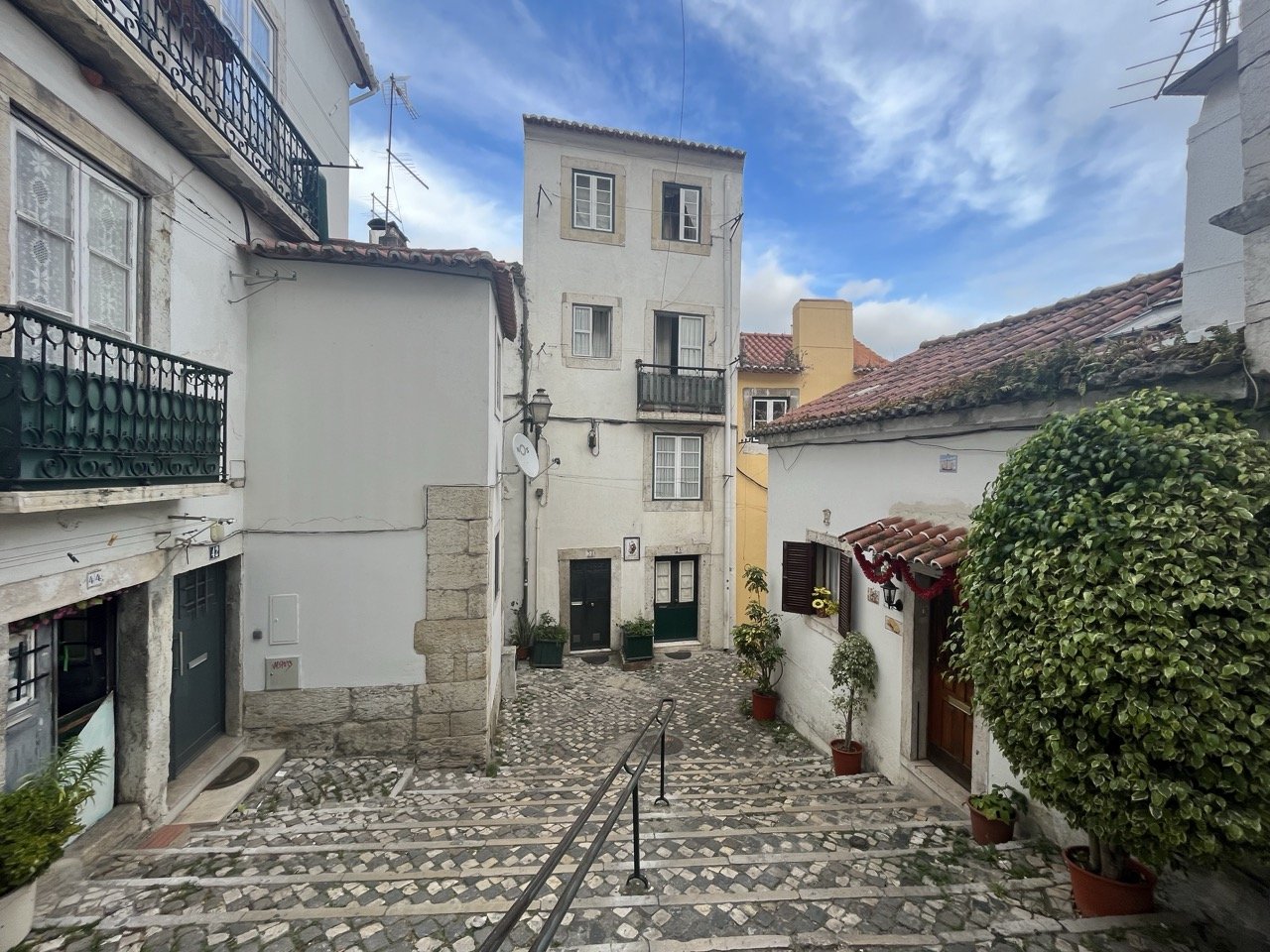Self-guided Walking Tour of Lisbon's Historic Center
Affiliate disclosure: some of the links in this article are affiliate links. If you book using one of them, we’ll earn a small commission. All of our info is free to read and free of ads, so we appreciate it!
Baixa and Chiado, together with Alfama, are the 3 neighborhoods that comprise Lisbon's central historic core. Other neighborhoods like Bairro Alto and the Mouraria are also in the city center, but they're different than the "historic center".
The route below covers Baixa, Chiado, and Alfama and will bring you along some of Lisbon's prettiest streets, past a few great lookout points, and into some marquee sites, squares, and churches (and a castle!).
The morning is dedicated to Baixa and Chiado while you'll spend a good part of the afternoon in Alfama.
Figure that you'll need 3-4 hours for the morning and around 3 for the afternoon (if you go inside the castle). These estimates give you plenty of time to take breaks, stop for a coffee, and do some wandering off route.
Let's have a look.
Lisbon planning cheatsheet
 Plan your itinerary with expert advice
Plan your itinerary with expert advice
- Book a Portugal travel consultation with a local expert
 My favorite hotels in Lisbon
My favorite hotels in Lisbon
- One Palácio da Anunciada - 5-star luxury off Avenida da Liberdade. $350/night
- Palácio das Especiarias - Old World charm & elegance in Chiado. $200/night
- Pousada de Alfama - modern little hotel in the heart of Alfama. $200/night
- Alegria Boutique Hotel - bright and airy rooms in Principe Real. $175/night
- Hotel Lis Baixa - small, but cheerful rooms for a bargain in Baixa. $150/night
- Hotel White Lisboa - excellent value with a pool in Avenidas Novas. $140/night
 Guided tours and activities
Guided tours and activities
- Private guided tours of Lisbon with Matilde (my favorite local guide)
- Tastes of Lisbon food tour
- Sintra & Cascais day trip (small group)
- Walking tour of the historic center (3 hours, small group)
- Private half-day Lisbon city tour by Tuk Tuk
 How to get around
How to get around
- Car rentals with DiscoverCars
- Metro and bus/tram routes with MetroLisboa and Carris
- Train tickets from Comboios de Portugal
- Taxis & rideshares with Uber and Bolt


The route
Morning - Baixa and Chiado
This first part of your route will take you roughly 3 hours, assuming you enter a few of the sights listed below. You also shouldn't only follow my route. Make sure to wander down some side streets, take the occasional staircase, and some exploring of your own.
I have a map below to show you a general idea of what the route is like. If you click the little button next to the blue "G” in the top left corner, you can see all the individual stops.
Praça do Comercio
I suggest starting the day in Praça do Comercio, Lisbon's largest square (and therefore Portugal's largest too) that opens up directly onto the Tagus River.
Enjoy the enormous space, walk down to the riverfront, and then stroll under the pretty arcades that line the square.
There are often events going on here, so it's a great place to start your visit to the city.
Praça do Comércio in Baixa
Praça Luis de Camões
From the Praça do Comercio, walk through the Arco da Rua Augusta (the giant archway) and make your way to Praça Luis de Camões square.
Make sure to walk along Rua da Augusta and then Rua Garrett where you'll pass by two famous sites: Livraria Bertrand (one of the oldest bookstores in the world) and the famous A Brasileira cafe, which was a famous haunt of famous Portuguese writers like Fernando Pessoa.
In my opinion, both have become tourist traps, but they're historic and pretty to see from the outside (and to take a peak inside). I wouldn't waste time going inside of either, however.
Praça Luis de Camões is one of Lisbon's most important squares and it always buzzing with life. It's named after a writer and poet who may be Portugal's most famous literary figure. The architecture all around is gorgeous, so take a seat somewhere and soak up the views and do some people watching.
Praça Luis de Camões in the Chiado neighborhood
Convento do Carmo
After some people watching and a meander through the streets surrounding Praça Luis de Comões (and perhaps a tasty Pastel de nata at A Manteigaria), head from the square over to Convento do Carmo.
Most of this convent was destroyed in the 1755 earthquake that ravaged Lisbon, but its arches and pillars are still standing and now form an open-air museum that is worth exploring. The site is also home to a small archaeology museum. Figure you'll want about an hour here.
Convento do Carmo. Photo: Pedro J Pacheco, CC BY-SA 4.0, via Wikimedia Commons
São Roque Church
After visiting the convent, continue your walk up to nearby São Roque Church. It may look plain on the outside but, in my opinion, it’s the most dazzling church in Lisbon. Take some time to explore the interior filled with gold, marble, semi-precious stones, hand painted tiles, and sumptuous paintings.
The interior of São Roque church. Photo: Simon Burchell, CC BY-SA 4.0, via Wikimedia Commons
Miradouro de São Pedro de Alcântara
A short (but steep) walk up from the church is the Miradouro de São Pedro de Alcântara, one of Lisbon’s most beautiful lookout points. It affords sweeping views over the city and out to São Jorge Castle. You can stroll the gardens with fountains and sculptures as you admire the views here or take a little coffee break at the open-air kiosk.
The view from the Miradouro de São Pedro de Alcântara
Calçada da Gloria to Praça do Rossio
From the viewpoint, walk along Calçada da Gloria (which has a picturesque tram track running down the middle of the street - great for photos when a tram passes) in the direction of Praça do Rossio, Lisbon's main square. On your map, you'll see it labeled "Praça Dom Pedro IV", but it's the same thing.
The square is the city's central meeting point and always packed with crowds of tourists and locals. The elegant Rossio train station is here too, so pop inside to have a look.
Praça do Rossio
Santa Justa Elevator
A few minutes’ walk from Rossio square brings you right in front of the famous Santa Justa Elevator, an iconic cast-iron construction designed by a student of Gustave Eiffel (yes, that Eiffel).
If the line is not insane, you should go up the elevator to enjoy the great view over the city. If, as it usually does, the queue snakes around the block, I'd skip it and just look from the outside down below.
Santa Justa Elevator
The view from the top


Afternoon - Alfama
As with this morning, figure that you'll want roughly 3 hours to meander through Alfama. This neighborhood is all tight alleyways and narrow streets with lots of stairs and uphills. So, expect to get some exercise. Because it's a very area neighborhood, know that the crowds can be intense.
I've included another map of this route below too. Keep in mind, the route here just touches on the main places in Alfama. You should not just follow this path. After stopping at the Miradouro de Santa Luzia, you should absolutely go down into the labyrinthine and weaving alleyways that make Alfama so incredibly charming and then rejoin the route.
Lunch
Stop for lunch somewhere around Rossio square or Santa Justa Elevator. From there, you'll head into Alfama.
This whole area is Lisbon at it's most touristy, so know that tourist traps abound. Do a little research and pick a good restaurant to avoid disappointment.
Sé de Lisboa cathedral
You'll be walking more this afternoon, so I'd recommend grabbing a taxi/Uber/Bolt from lunch to Sé de Lisboa cathedral at the very beginning of Alfama. The church is not the most impressive you'll ever see, but it's worth taking a look inside.
Sé de Lisboa cathedral
Get a little lost
From here, here you should turn off Google maps and put your phone away. The pleasure of visiting Alfama is to wander aimlessly and see where your senses take you. So, let yourself do just that for an hour.
Now, if you don't like my idea of getting lost, I have put together a route for you. You're welcome ;)
A typical Alfama scene
Miradouro de Santa Luzia and Miradouro das Portas do Sol
From the cathedral, it'll take you 10 minutes to walk to two of Lisbon's most iconic viewpoints: Miradouro de Santa Luzia with its beautiful blue azulejos that depict the Reconquest of the city and Miradouro das Portas do Sol (they are right next to each other).
There are two streets that you can take to get there and both are nice.
The view from Miradouro de Santa Luzia
Panteão Nacional
After enjoying the panoramas, head over to the Panteão Nacional. Once a church, the building is now a sort of mausoleum that is the final resting place of important people from Portuguese history. It's a beautiful building.
To get here, walk along Rua das Escolas Gerais, past Largo do Sequeira, and then up to the monument. It'll take you 15-20 minutes, but I'd budget a bit longer as the streets you'll walk along are really pretty and you'll definitely wind up stopping and detouring.
If you're here on a Tuesday or Saturday, the square adjacent to the Panteão hosts a great flea market (Feira da Ladra) on those days.
Panteão Nacional. Photo: Arne Müseler / www.arne-mueseler.com, CC BY-SA 3.0 DE, via Wikimedia Commons
Igreja de São Vicente de Fora
10 more minutes will bring you to the Igreja de São Vicente de Fora, a beautiful church and monastery with great views from its rooftop. Many kings from the Braganza family dynasty are buried here and the interior of the church is beautiful and has some excellent Portuguese tiles.
For me, the highlight is a visit to the rooftop from where you have views over the Panteão and out onto the Tagus River. Entry is just 8 euros. Learn more here.
São Vicente de Fora rising over Alfama. Photo: Vitor Oliveira from Torres Vedras, PORTUGAL, CC BY-SA 2.0, via Wikimedia Commons
The church's rooftop. Photo: Gerd Eichmann, CC BY-SA 4.0, via Wikimedia Commons
São Jorge Castle
Finish your exploration of Alfama with a visit to the São Jorge Castle and a walk along its wonderful ramparts looking down over the city. It'll take you 15 minutes to get here from São Vicente de Fora.
How long you spend here really depends on how fast you move, but anywhere from 1-2 hours is pretty standard.
Walking along the ramparts at São Jorge castle. Photo: Simon Burchell, CC BY-SA 4.0, via Wikimedia Commons


More Portugal travel info
For more advice on planning your trip to Portugal, have a look at some of our other guides and itineraries!
Lisbon
Porto
Algarve
Portugal

Connect with a Local Expert
























